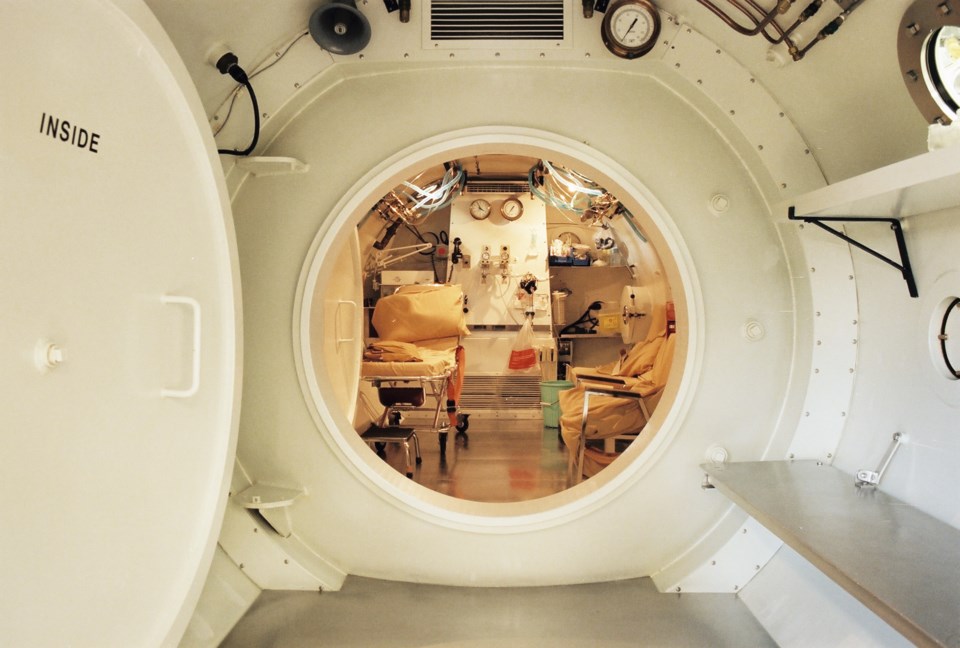Vancouverâs Arlene Nguyen says she will never forget the day she was poisoned by carbon monoxide.
âI was home with my brother and we both started shaking, become dizzy and lightheaded, and our speech was slurred.â
Luckily, the 19-year-old was able to call 911 and the siblings were rushed to Â鶹´«Ã½Ó³»General Hospital where they were treated in the hyperbaric chamber. The pair was among the 36 patients treated in the hospitalâs hyperbaric chamber for carbon monoxide poisoning last year. And several other patients were seen in the emergency room or admitted to the hospital for a higher level of care.
âMost cases of carbon monoxide poisoning are preventable,â Dr. Bruce Campana, a hyperbaric physician at Â鶹´«Ã½Ó³»General Hospital, said in a press release. âWhether itâs the gas in your furnace, the wood in your fireplace or the propane in your stove, if it burns a fossil fuel, it produces carbon monoxide.â
Â鶹´«Ã½Ó³»Coastal Health says it sees more cases of carbon monoxide poisoning in the winter months because people are using furnaces and fireplaces to keep warm.
It is often referred to as âthe silent killerâ because it doesnât smell, is invisible and if you inhale too much, it can be deadly.
Â鶹´«Ã½Ó³»General Hospital has the only government-approved and medically-supervised public hyperbaric chamber in B.C. and sees patients from across the province.
The chamber might look like a submarine, but itâs a high-tech piece of medical equipment â compressors are used the raise or lower the atmospheric pressure, allowing the operators to increase blood-oxygen levels.
âIncreasing oxygen in the blood of carbon monoxide patients helps get rid of carbon monoxide and promotes healing,â said Campana. âWhile we are grateful to have this unique medical device, prevention is the key.â
The Nguyen family now has working carbon monoxide detectors in their Â鶹´«Ã½Ó³»home.
âBeing poisoned by carbon monoxide was definitely a wakeup call,â Nguyen said.Ìý âIt happened so quickly; I urge everyone to get a carbon monoxide detector.â
Ìý
10 facts about carbon monoxide:
1) What is carbon monoxide (CO)?
Carbon monoxide is a colourless, odourless gas produced by the burning of any fossil fuel. It doesnât smell, itâs invisible, and if too much is inhaled, it can be deadly. It is often referred to as âthe silent killerâ.
Ìý
2) Can electric heaters cause CO poisoning?
No, unless they cause a fire.
Ìý
3) Can natural gas or propane cause CO poisoning?
Yes. Any fossil fuel (gasoline, natural gas, propane, butane, oil, kerosene, wood, charcoal, even methanol) will release CO when burned.
Ìý
4) Is carbon monoxide the same as carbon dioxide?
No. Carbon dioxide is exhaled when you breathe, and is not poisonous. Carbon monoxide is very poisonous, and is responsible for more deaths every year than any other gas.
Ìý
5) How does CO poisoning show up?
Common symptoms include headache, dizziness, nausea and vomiting. More severe cases can cause seizures, heart attacks, loss of consciousness, irreversible brain damage and death. In early stages, it can be difficult to tell apart from food poisoning. If multiple people in a home or office feel sick at the same time, always consider CO poisoning.
Ìý
6) How can I prevent CO poisoning?
Make sure all furnaces, fireplaces and gas ranges are properly vented. An annual check by a professional is recommended. Except for a fireplace and a professionally installed gas cooktop, donât burn indoors. Never use a barbecue or gas heater inside. Never run a generator or gas powered pressure washer inside, even in a garage. Your house will not have the ventilation needed to run any gas engine inside, ever.
Get a CO detector. Better yet, get more than one. Put them near the main living area. Carbon monoxide often kills people while they sleep, so also having detectors near all bedrooms is recommended.
Ìý
7) I have a smoke detector. Is that the same as a CO detector?
No. You should have both, as you can have smoke suggesting a fire without much CO, or have dangerous amounts of CO without smoke. Many companies sell a combined unit. If youâre not sure, ask someone at the store.Ìý
Ìý
8) What should we do if the CO detector sounds an alarm?
The safest thing to do is get everyone out of the house into fresh air, and call 911. The fire department can check the home for CO levels, and advise you if it is safe or not.
Ìý
9) How is CO poisoning treated?
First, get everyone to a safe area. Call 911 as soon as possible. First responders will apply oxygen. In severe cases, patients may need to go to a hospital. Some may need treatment in a hyperbaric chamber.Ìý
Ìý
10) Where can I get more information about CO poisoning?



